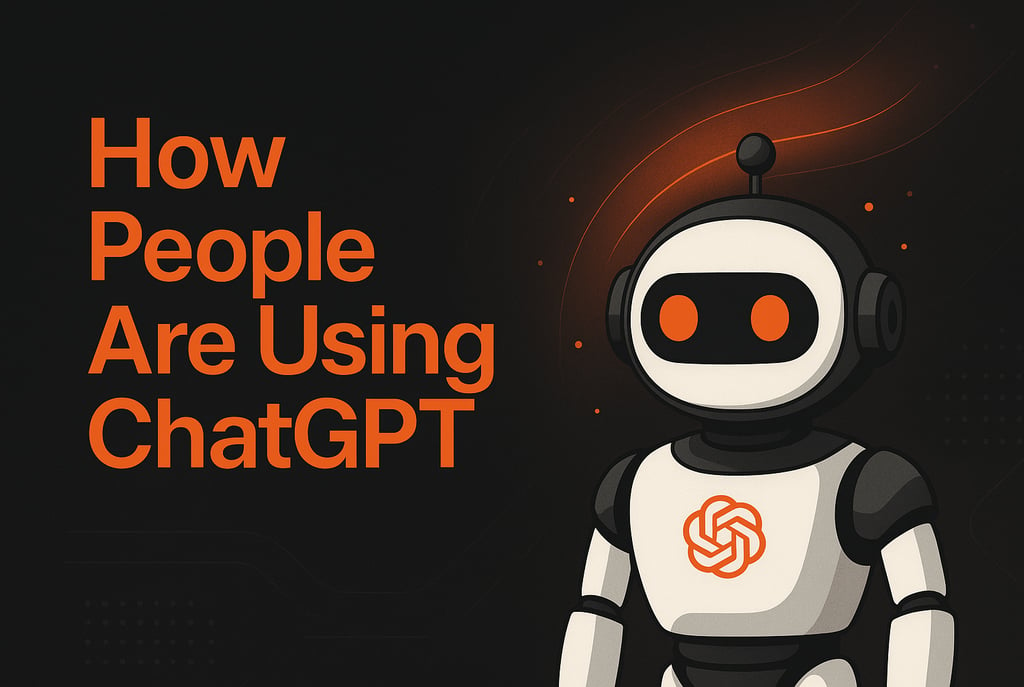ChatGPT Isn’t Just a Writing Tool — It’s Becoming the New Customer Journey
OpenAI’s landmark study shows ChatGPT is no longer just a writing tool — it’s becoming a trusted advisor. Nearly half of all interactions are about seeking advice, comparisons, and decision support. For SMEs, this changes the game: if your content isn’t AI-ready (clear, factual, structured, and useful), you risk being filtered out before customers even see you. This blog breaks down the study’s key findings, the shifts in consumer behaviour, and how SMEs can turn AI into a growth opportunity by focusing on visibility, utility, and trust.
9/25/20253 min read


ChatGPT Isn’t Just a Writing Tool — It’s Becoming the New Customer Journey
OpenAI has just dropped its biggest-ever study into how people actually use ChatGPT.
No hype. No futurism. Just millions of real conversations, analysed.
And the results should make marketers — especially those working with SMEs — sit up.
Because this isn’t about productivity hacks. It’s about how your customers are researching, comparing, and deciding what to buy. And if your brand isn’t visible in those moments, you’re invisible full stop.
The Data: How People Really Use ChatGPT
The research categorised usage into three buckets:
Asking (49%) – people looking for advice, recommendations, explanations.
Doing (40%) – task completion: drafting, planning, editing.
Expressing (11%) – reflective or exploratory conversations.
When you zoom in further, 80% of all conversations are about three things:
Practical guidance – how-to advice, tutoring, brainstorming.
Seeking information – conversational search and fact look-ups.
Writing – drafting, editing, translating, critiquing.
Other takeaways:
Only 30% of use is work-related, but writing dominates within that.
70% is personal use — and personal habits are bleeding into work expectations.
Writing tasks are declining, while practical guidance is rising. ChatGPT is evolving from ghostwriter to trusted advisor.
Demographics are shifting fast: the gender gap has closed, younger users dominate, and adoption in lower- and middle-income countries is accelerating.
What This Means for Marketers
Let’s cut through the noise. Here’s what these findings really mean for SME marketing.
1. AI Is a New Gatekeeper in the Funnel
Nearly half of interactions are people asking questions like:
“Which supplier is best for X?”
“What’s the difference between A and B?”
If you’re not part of those answers, you don’t make the shortlist.
Search engines aren’t the only discovery channel anymore. AI assistants are shaping what customers see and trust before they ever reach you.
2. Utility > Persuasion
The heavy tilt towards practical guidance means customers want useful content they can act on — not just polished marketing copy.
That means:
Step-by-step guides
Templates and checklists
FAQs written in plain English
Case studies that explain “how,” not just “why”
If your content doesn’t help people do something, it won’t stick.
3. AI-Readiness Is the New SEO
Ten years ago, SMEs scrambled to optimise for Google. Now you need to optimise for AI.
That means content that is:
Clear – no jargon, no fluff.
Structured – logical, scannable, easy for AI to parse.
Trustworthy – evidence-based and credible.
If ChatGPT can’t interpret your content, it won’t surface your brand.
4. Consumer Expectations Have Leveled Up
Daily AI use changes behaviour. Customers now expect brands to:
Offer AI-style convenience (self-service, conversational touchpoints).
Be personalised and responsive, not one-size-fits-all.
Show AI literacy — clunky digital journeys look even worse in an AI-first world.
5. Audience Shifts = Messaging Shifts
Younger audiences are setting the tone: informal, AI-native, fast-moving.
Broad adoption (closed gender gap) means AI isn’t niche anymore.
Emerging markets are adopting at pace — opportunities if you operate globally.
6. Risks to Watch
Overreliance: AI content without human oversight dilutes brand voice.
Trust & authenticity: customers want to know what’s real.
AI gatekeeping: if assistants filter you out, you may never be seen.
Compliance: SMEs can’t afford to get privacy, ethics, or transparency wrong.
How AI Is Changing Buyer Behaviour
Beyond marketing strategy, this study highlights how consumer behaviour itself is shifting:
Lower friction in research: AI simplifies options instantly. Your differentiation must be clear.
DIY orientation: customers expect tools, guides, and self-service — not hand-holding.
Personalisation & co-creation: AI adapts to the user; brands must do the same.
AI as gatekeeper: if you’re not top-of-mind for assistants, you don’t get seen.
Clarity & rigour: AI rewards straightforward, well-structured information. Fluff gets filtered.
The SME Growth Playbook
For SMEs, this is both warning and opportunity. You can’t outspend the big players. But you can out-think and out-adapt them.
Here’s where to start:
Audit your content – would ChatGPT surface it in an answer?
Build for utility – guides, toolkits, and practical assets > slogans.
Embed AI in service – smarter FAQs, onboarding journeys, conversational tools.
Stay human – oversight, credibility, and authenticity matter more than ever.
Final Word
ChatGPT isn’t just a productivity tool. It’s already shaping how your customers research, learn, and decide.
If you’re not visible, useful, and trusted in AI-driven journeys, you won’t even make the shortlist.
For SMEs, this isn’t tomorrow’s challenge.
It’s today’s growth opportunity.
vibe MKTG Ltd is incorporated in England and Wales under company number 13728564.
vibe MKTG® is a registered trademark. All rights reserved.
Site designed by: AI Conductor + ChatGPT.